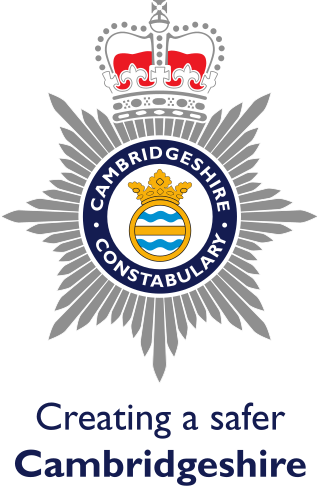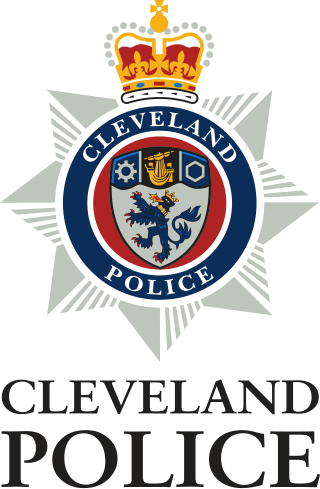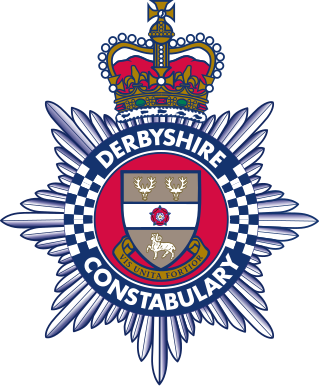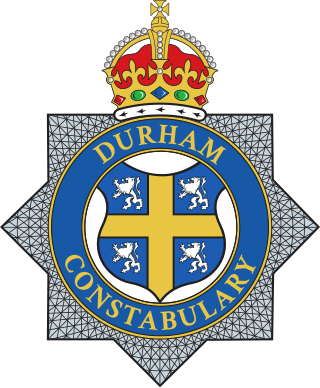
West Mercia Police, formerly the West Mercia Constabulary, is the territorial police force responsible for policing the counties of Herefordshire, Shropshire and Worcestershire in England. The force area covers 2,868 square miles (7,430 km2) making it the fourth largest police area in England and Wales. The resident population of the area is 1.19 million Its name comes from the ancient kingdom of Mercia.

Cheshire Constabulary is the territorial police force responsible for policing the ceremonial county of Cheshire in North West England, comprising the unitary authorities of Cheshire East, Cheshire West and Chester, Borough of Halton and Borough of Warrington. The force is responsible for policing an area of 946 square miles (2,450 km2) with a population of approximately 1 million people.

Avon and Somerset Police is the territorial police force responsible for law enforcement in the five unitary authority areas of Bristol, Bath and North East Somerset, North Somerset, Somerset, and South Gloucestershire, all in South West England.

Bedfordshire Police is the territorial police force responsible for policing the ceremonial county of Bedfordshire in England, which includes the unitary authorities of Bedford, Central Bedfordshire and Luton. Its headquarters are in the town of Kempston in Bedford Borough.

Cambridgeshire Constabulary is the local territorial police force that covers the county of Cambridgeshire and Peterborough unitary authority. It provides law enforcement and security for an area of 1,311 square miles (3,400 km2) and population of 856,000 people, in a predominantly rural county. The force of Cambridgeshire includes the cities of Cambridge, Ely and Peterborough, the market towns of Chatteris, Huntingdon, March, Ramsey, St Ives, St Neots, Whittlesey, and town and Port of Wisbech. Its emblem is a crowned Brunswick star containing the heraldic badge of Cambridgeshire County Council.

Cleveland Police is a territorial police force in England responsible for the policing the boroughs of Middlesbrough and Redcar and Cleveland in North Yorkshire and Hartlepool and Stockton-on-Tees in County Durham within North East England. The force is overseen by the Cleveland Police and Crime Commissioner. Since 2022, the chief constable has been Mark Webster.

Cumbria Constabulary is the territorial police force in England covering the unitary authority areas of Cumberland and Westmorland and Furness in the ceremonial county of Cumbria. As of September 2017, the force had 1,108 police officers, 535 police staff, 93 police community support officers, and 86 special constables.

Derbyshire Constabulary is the territorial police force responsible for policing the county of Derbyshire, England. The force covers an area of over 1,000 square miles (3,000 km2) with a population of just under one million.

Devon and Cornwall Police is the territorial police force responsible for policing the ceremonial counties of Devon and Cornwall in South West England. The force serves approximately 1.8 million people over an area of 3,967 square miles (10,270 km2).

Leicestershire Police is the territorial police force responsible for policing the counties of Leicestershire and Rutland in England. Its headquarters are at Enderby, Leicestershire.

Lancashire Constabulary is the territorial police force responsible for policing the ceremonial county of Lancashire in North West England. The force's headquarters are at Hutton, near the city of Preston. As of September 2020, the force has 3,088 police officers, 190 special constables, and 280 police community support officers (PCSO), 300 police support volunteers (PSV), and 2,287 staff.

Dorset Police is the territorial police force responsible for policing the county of Dorset in South West England, which includes the largely rural area covered by Dorset Council, and the urban conurbation of Bournemouth, Christchurch and Poole.

Durham Constabulary is the territorial police force responsible for policing the council areas of County Durham and Darlington in North East England. It does not cover all of the ceremonial or historic area of Durham, parts of which are covered by the neighbouring forces of Cleveland Police and Northumbria Police. The other neighbouring forces are Cumbria Constabulary to the west and North Yorkshire Police to the south.

His Majesty's Inspectorate of Constabulary and Fire & Rescue Services (HMICFRS), formerly Her Majesty's Inspectorate of Constabulary (HMIC), has statutory responsibility for the inspection of the police forces of England and Wales, and since July 2017 the fire and rescue services of England. HMICFRS is headed by the Chief Inspector of Constabulary and Chief Inspector of Fire & Rescue Services. It has taken over the responsibilities of His Majesty's Fire Service Inspectorate.

Nottinghamshire Police is the territorial police force responsible for policing the shire county of Nottinghamshire and the unitary authority of Nottingham in the East Midlands area of England. The area has a population of just over 1 million.

Northamptonshire Police is the territorial police force responsible for policing the county of Northamptonshire in the East Midlands of England, in the United Kingdom.

Avon Fire & Rescue Service (AF&RS) is the fire and rescue service covering the unitary authorities of Bath and North East Somerset, Bristol, North Somerset, and South Gloucestershire in South West England.
The Gloucestershire Fire and Rescue Service is the statutory emergency fire and rescue service for the non-metropolitan county of Gloucestershire, England. The service is run by Gloucestershire County Council. The service does not cover the unitary authority of South Gloucestershire which is covered by Avon Fire and Rescue Service.

The Northamptonshire Fire and Rescue Service (NFRS) is a fire and rescue service covering the county of Northamptonshire, United Kingdom. NFRS covers an area of 948 square miles (2,460 km2) area with a population of around 750,000.

In England and Wales, the principle of the National Crime Recording Standard is to direct how statistics about notifiable offences are collected by police forces. An important distinction is made between notifiable offence recording and police incident reporting. The National Crime Recording Standard is about how statistics about notifiable offences are recorded. The National Standard for Incident Recording direct how information and statistics about police non-crime incidents are recorded. The Government has delegated the task of inspecting a police forces compliance with the National Crime Recording Standard to Her Majesty’s Inspectorate of Constabulary and Fire Rescue Service (HMICFS), previously called Her Majesty’s Inspectorate of Constabulary.





















